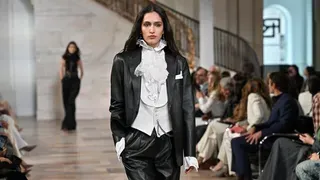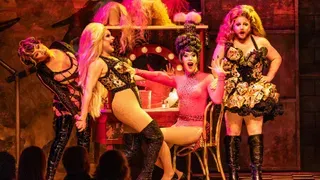March 26, 2017
Mary Tyler Moore: Style Icon and Godmother of the Pussy Hat
Andy Smith READ TIME: 5 MIN.
When Mary Tyler Moore died on January 25 at age 80, we lost a symbol of women's independence and a low-key gay icon.
As perfect wife Laura Petrie on "The Dick Van Dyke Show" and perfect single "girl" Mary Richards, Moore epitomized style on a budget and set a standard for living the single life in the days before same-sex marriage.
For gay men and lesbians of a certain age, Mary's independent life looked fun, free, exciting and -- in choosing Minneapolis over New York or LA -- doable for sissies and girls who weren't looking for husbands growing up in small towns and midsize cities across the country.
True Groundbreaking TV
Former Entertainment Weekly reporter Jennifer Keishin Armstrong wrote the 2013 book "Mary and Lou and Rhoda and Ted: And All the Brilliant Minds Who Made the Mary Tyler Moore Show a Classic," a comprehensive look at the show's difficult path to success. The show replaced "hicks in the sticks" series like "The Beverly Hillbillies" and "Green Acres," ushering in a TV revolution that turned Saturday night on CBS into must-see television featuring "All in the Family," "The Bob Newhart Show" and, of course, "The Mary Tyler Moore Show."
Like many kids growing up in the '70s and '80s, Armstrong put down her dolls to play-act situations involving Mary and faux-bohemian sidekick Rhoda (Valerie Harper, who earned a successful spinoff in 1974). Did anyone want to play Cloris Leachman's judgmental landlady Phyllis Lindstrom?
Running from 1970 to 1977, "The Mary Tyler Moore Show" even featured one of the daring 1970's best unsung "gay" episodes. In a decade that saw worthy but heavy-handed plots involving gay characters (think "Soap," "All in the Family" or "Maude" and company visiting a gay bar in Tuckahoe!), "My Brother's Keeper" (1973) is one of the shows best, making hay from the long-standing frienemy relationship between Phyllis and "dumb, awful Rhoda."
Tension builds as Phyllis's handsome, talented, single brother (Robert Moore) chooses to spend more time with Rhoda instead of Mary. Finally, an overwrought Phyllis confronts Rhoda, asking if they're engaged. In a classic exchange:
Rhoda Morgenstern: Ben and I aren't getting married - he's not my type!
Phyllis Lindstrom: What do you mean, he's not your type? He's witty, he's attractive, he's successful, he's single ...
Rhoda Morgenstern: He's gay!
"It's one of their best episodes. The joke is you think she [Phyllis] might freak out. But instead, Phyllis is like, 'Oh, thank god he's gay,'" says Armstrong.
"At the time it was still taboo enough that it was a huge deal, and the show got one of their longest laughs in the studio. The whole episode is a buildup to the reveal. It's actually the opposite of cheesy, because it [his sexuality] is not a big deal."
Pussy Hat Riot
"It may have been the original Pussyhat. The beret toss in the opening credits of 'The Mary Tyler Moore Show,' which ran from 1970 to 1977, wasn't just a style flourish, it was a call to action for a generation who looked to the lead character, Mary Richards, as a role model," read the lead to a Hollywood Reporter piece that ran the week Moore died.
And in the four decades since her show left the air (at its peak), an A-list of top designers, including Michael Kors, Zac Posen and Isaac Mizrahi, have drawn inspiration from Mary Richards' style, much of which was created by costumer designer Leslie Hall, who often pulled pieces from designer Evan Picone's collections for Mary's workplace look.
The look inspired Mizrahi collections for Target and Liz Claiborne in the '90s and '00s, and it remains an up-to-the-minute source today, with her working "girl" look referenced in Posen's Spring 2016 collection for Brooks Brothers and Kors' Spring 2017 runway collection.
In Mizrahi's words, "It wasn't money or special privilege that gave her style. She made all women feel like they, too, could be stylish and have happy stories."
Happy Homemaking for One
The writers' vision for Mary's apartment:
"A room. Actually an entire apartment, but a single large room. There are some -- mostly of the working girl variety -- who would consider this a 'great find': ten-foot ceilings, peg-wood floors, a wood-burning fireplace, and, most important, a fantastic ceiling-height corner window. Right now, the room is empty, but it won't be for long. It will be the main setting for
'The Mary Tyler Moore Show.'
So God Bless It."
While Mary Richards' personal style inspired many growing up in the 1970s, her large studio apartment became a template for DIY style. One episode even featured Mary "antiquing" a wooden chair, lashing it repeatedly (while giggling) with a metal chain.
Growing up in Tennessee, LA-based architect Andy Allison was always a fan of The Mary Tyler Moore Show's aesthetic.
"Whenever I watch the show, I'm watching the background," says Allison. "I've become a collector, though not a hoarder yet. So if I'm shopping and see something from 'The Mary Tyler Moore Show,' I rescue that."
He believes '70s design and architecture is ripe for preservation. "As an architect, I haven't been able to use the show's design sense or style for a project yet."
"I've bought stuff from her apartment that's in my house, including the pumpkin cookie jar and the tulip-shaped 'laurel lamp.' I've got a couple of those," he says. "For years I also had a big 'A' in my kitchen. When I win the lottery, I'm going to do a full Mary aesthetic."
Allison admits his Mary fetish did extend beyond design. "My friend was also a big fan of the show. So one Halloween we all went as the MTM cast, but we had real girls as Mary and Rhoda and Phyllis. I had to go as Ted," he says.
Ready for More More Moore?
For anyone new to the cult of Mary, the best way to begin your journey of discovery is to catch the series, which found humor in light topics (bad hair days), dating (in the last season, Mary tabulates that she's been on "2,000 dates") and even divorce and funerals ("Chuckles Bites the Dust," often cited as the best sitcom episode ever).
And then follow it up by downloading Armstrong's book, a great behind-the-scenes look at a project that proved to be a positive experience for everyone involved -- from the cast, to creators Allan Burns and James L. Brooks ("The Simpsons," "Broadcast News"), to writers like Treva Silverman, who broke ground for women in television.
Allison hopes his lonely cult will grow. "It seems like there may be only a handful of people who are true believers. I kind of have to keep it all to myself."
The Darker Side of Perfection
"I cannot respond when someone says, 'Here, I just did this great thing. Love me!"
-Ordinary People
A final argument for Mary Tyler Moore as "sleeper" gay icon is her surprising range, which includes a gallery of darker roles. There's no "Baby Jane," but her multidimensional portrayal of Beth Jarrett in Robert Redford's "Ordinary People" qualifies as one of cinema's best ice queens.
In a subtle performance that holds up under repeated viewings, she found the dark side of superficial perfection, losing a tight Oscar showdown to Sissy Spacek's Loretta Lynn ("Coal Miner's Daughter") in a squeaker.
Back on TV, Moore successfully played against type on a number of occasions, digging into the dark side of "Little Miss Perfect" as neurotic Mary Todd Lincoln in Gore Vidal's "Lincoln" (1988), an uncompromising editor in the 1995 series "New York News" (13 episodes scheduled against "Seinfeld"), the head of a Southern orphanage running a black-market baby scam in 1993's "Stolen Babies" (earning the last of her six Emmys) and as a manipulative sociopath in true-crime "Like Mother Like Son: The Strange Story of Sante and Kenny Kimes" (2001).




